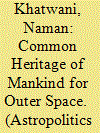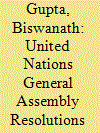|
|
|
Sort Order |
|
|
|
Items / Page
|
|
|
|
|
|
|
| Srl | Item |
| 1 |
ID:
167856


|
|
|
|
|
| Summary/Abstract |
The paper examines the intention of the drafters of the Outer Space Treaty regime to advance from the principle of “common province of mankind” and adopt “Common Heritage of Mankind”. In this context, the drafting history of the Moon Agreement, which helps discern the meanings ascribed to Common Heritage of Mankind by various countries, is considered. Moreover, the usage of the term in other realms, such as the deep seabed regime and Antarctica, is essential to understand the concept. The introduction of Common Heritage of Mankind in the United Nations Law of the Sea led to various industrialized developed countries, including the United States, to oppose the law. Hence, the approach was diluted to ensure it converts into a more liberal condition that does not enforce strict mandates on parties to the Law of the Sea. A similar view of states exists with respect to the Moon Agreement resulting to date in only 17 ratifications by states with no spacefaring states among them. Consequently, most states argue that the Common Heritage of Mankind principle in the Moon Agreement is not applicable due to not being party to the agreement. It is also argued that since there is no state practice suggesting opinion juris regarding Common Heritage of Mankind, it is not part of customary international law. The non-inclusion of the principle as a customary norm makes the relevance of Common Heritage of Mankind in the present world debatable and uncertain.
|
|
|
|
|
|
|
|
|
|
|
|
|
|
|
|
| 2 |
ID:
167858


|
|
|
|
|
| Summary/Abstract |
The paper examines the linkage between satellites and the security dilemma. There are currently over 2000 satellites in Earth orbit with various applications ranging from observations, remote sensing, telecommunications, to navigation, among other uses. This multitude of possible usages cause uncertainty concerning intentions and fear in the international system, which leads to security build-ups. This paper first looks at the dual-use nature of satellites and by giving examples, explains what exactly is meant by this. Second, it delves into the theories behind the security dilemma, especially analyzing the differences in theory between offensive and defensive weapons. And third, it builds on the theory concerning the security dilemma to examine how exactly satellites and their dual-use applications affect the dilemma.
|
|
|
|
|
|
|
|
|
|
|
|
|
|
|
|
| 3 |
ID:
167857


|
|
|
|
|
| Summary/Abstract |
Outer space, as the ultimate high ground, offers potential for contributing towards maritime domain awareness, which is dependent on Intelligence, Surveillance, and Reconnaissance (ISR). This research discusses several utilizations and limitations of space technologies in the realm of maritime ISR through use of electronic intelligence, and electro-optical and radar imagery payload sensors. Technological and financial options for nascent and smaller space powers through dual-purpose commercial and civilian space technologies towards sea surveillance are elaborated as well. Finally, from an operational perspective of ISR, the methodology of frame-by-frame mosaicking of satellite images utilizing commercial remote sensing satellites towards space-based maritime ISR is explained using hypothetical scenarios.
|
|
|
|
|
|
|
|
|
|
|
|
|
|
|
|
| 4 |
ID:
167855


|
|
|
|
|
| Summary/Abstract |
The launch of Sputnik in 1957 followed by Explorer in 1958 showcased the potential of space and stressed the need for a robust body of law legislating space as beneficial to all states. Following the launches, a series of resolutions by the United Nations’ General Assembly developed the core principles of international space law. This article conducts an analysis of resolutions passed from 1957 to 1967 to understand the genesis of space law principles as reflected in the Outer Space Treaty of 1967. These principles include sovereign equality, peaceful purposes and international cooperation, non-appropriation of space, common heritage of mankind, environmental protection, and how to address non-governmental entities engaged in space activities.
|
|
|
|
|
|
|
|
|
|
|
|
|
|
|
|
|
|
|
|
|